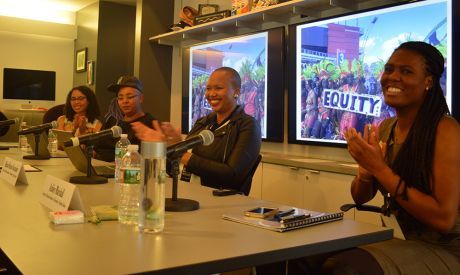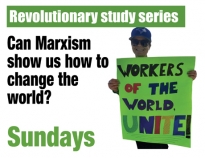Reports
You are here
The Black left: left out and underestimated

April 8, 2018
Celebrating the rigour and style of Blackness, and puncturing the prevailing ideologies and practices of racism, Black Portraitures IV: The Color of Silence brings Black scholars, activists, and artists together to discuss the dualities between Black pain/love, Black history/futurism, and Black sisyphean questions and futuristic strategies, with a through-line of Black care. Hosted by the Hutchins Center for African and African American Research at Harvard University, Black Portraitures is a conference that advances the institute’s aim to excite interest in the field. From March 21-25, I (Kevin) had the sincere pleasure of accompanying Ashley Marshall, who’s project called The Black Left: Left Out and Underestimated, was accepted for presentation. Ashley, a professor of communications at Durham College, was flanked by Allison Hector-Alexander, the Director of Durham College’s Committee for Diversity, Inclusion, and Transitions; Maya Annik Bedward, a Toronto based documentary filmmaker and founder of Third Culture Media; and LeRoi Newbold, member of Black Lives Matter - Toronto and Director of the Freedom School.
In the Hip Hop Archive of the Hutchins Center, these panelists illuminated conversations about the grassroots left, most powerfully by critiquing the reputation of former President Barack Obama as being the portrait of the Black left. Rather, these panelists pulled from eminent scholarship to radicalize the potential of the American Black left, and implored audiences to think again about the role of the presidency. Poignantly, this panel echoed the inquiry rampant in the Black left’s post-Obama era, asking ”why do we need presidents?”.
Ashley used this public academic space to elaborate upon the sentiments she amplified here first, namely that of the Black left to analyze systems of power, even if these systems allow a Black person to wield power. She brought with her cultural workers who exchanged various strategies and forms of resistance, and resilience. The following is a report of that experience.
My (Ashley’s) aim writing this is a combination of forces. First, I want to celebrate my culture and relish in the joy of learning so much about it. Black Potraitures is an incredible event. I also want to contextualize it, and recognize that this conference happened at the same time as the Boston March for Our Lives rally. Lastly, the combination of these occurances led me to realize many facets of my activism, which I share with you now.
As educators, Allison and I discussed the impact that culture has when forming identity and ideology. We agreed that in the academy, much emphasis needs to be placed in building relationships with students foregrounded in “encouraging Socratic reflection, critically examining everyday life.” Such a project requires the understanding that societies change when people - namely students - see themselves reflected in that society, which is a particularly contemporary conversation. My lecture was given with my position as an educator deliberately centered, for teachers, of all stripes, will be called upon as leaders on the fronts of any social change. In this moment, it is timely and necessary to be preoccupied with the following concept: “what are today’s young activists dreaming about? We know what they are fighting against, but what are they fighting for?”(Robyn Kelley, 2002. Freedom Dreams: the Black Radical Imagination. “When History Sleeps: A Beginning”, 7-8). Engaging youth in these questions, and propelling these imaginings further is a mandatory component of the emancipation of Black people, and by extension, everyone.
The experience of socialism in Canada can be, for those couched in the Latin American or Jamaican ethos of socialism, alienating while they exist in a diaspora. Yes, we demonstrate our power on a regular basis. Intricate networks of leftists necessarily exist inside marginalized communities. Active and inclusive groups center and uplift the people with which they work—often racialized people. The absence of this method makes movements (and the intellectuals writing about them) irrelevant.
Hence, this intervention is necessary. If the disimagination machines remain supreme—such as lazy media, under-resourced education, prioritization on capital instead of self-fulfillment, and other neoliberal logics of maintaining the status quo—then there is little hope for radical left momentum. If grassroots socialism—including experiences captured through music, dance, and art of all other forms—is sidelined, then differing cultural expressions of socialism risk becoming homogenized into one North American understanding of what it means to be socialist. There must be a more robust way of highlighting the different, valuable ways that socialism can take shape, rather than being distracted by conversations of, “is this or that politician really a socialist?” As was exemplified at the Black Portraitures conference, producing new knowledge and sharing experiences inspires new questions; cornerstones of what is required to become free.
The theme of this year’s conference was the “color of silence.” I made a point to pay tribute to Courtlin Arrington during my presentation. I made a point, also, to commend the students of the Parkland school massacre and their sister demonstrators, namely those who walked out of school for 17 minutes to commemorate the 17 people who lost their lives. I made a point, meanwhile, to also express that the occupancy should have lasted 18 minutes (at least) so that Courtlin too could be mourned. Such an act would unite various experiences of gun violence and weave together a stronger example that many oppressions can be opposed simultaneously, much like several shows of socialism can—and do—operate alongside one another. More consciousness is needed in public spaces and conversations so that socialism, as a broad practice and anchoring ideology can be as pervasive as possible.
The history of socialism in America and the violent labour wars of the early 20th century can only be wholly understood when the integral roles of Black socialists are recognized. After the Russian Revolution, Black people in America looked to the nascent, radically egalitarian country as a source of inspiration. Like W.E.B. Du Bois, Lenin specifically stated that Black people in the US were among the most oppressed peoples in the world, and that their involvement in the international socialist movement must be central. Black people entered and became involved in the US Communist party while they were systematically (or explicitly) excluded from in other movements and parties.
The red-baiting backlash that the American state accelerated after the First World War was wielded against Black people simultaneously. The twin threats to American power of Black uprising and socialism were wedded in public discourse by reactionary law enforcers like J. Edgar Hoover. Additionally, racist white militias carried out murder campaigns against Black workers organizing for their own power. A generation later, Black socialists spearheaded the decade of rebellion in the 1960s, including Malcolm X, the Black Panther Party, and the explicitly anti-capitalist Martin Luther King Jr., who has been defanged to the point of acceptability by the majority white press and education system. To omit the contributions of Black socialism from the history of the left is to engage in revisionism and racism.
This is precisely the value that a conference like Black Portraitures has, not for its elite location this year (the conference switches up the host city each time), but for its providing of a space to revive histories and developments about the Black left today. Black Portraitures was a worthy experience, one that left me feeling inspired and motivated to work more, to engage with the community more, and to read and listen and read some more. And it left me poised to act. I left my panel asking the audience to recognize the privilege we exude while we “observe” the struggles of others. I quoted Bob Marley, who asked “how long shall they kill our prophets, while we stand aside and look?” How long shall they keep their profits while we stand outside, or read a book? I want to highlight and pay homage to those who fight for freedom in different, arguably more radical ways.
In his text “Rethinking Black Working-Class Opposition in the Jim Crow South,” Robin D.G. Kelley outlines the tradition described by James C. Scott called “infrapolitics”: “the circumspect struggle waged daily by subordinate groups is, like infrared rays, beyond the visible end of the spectrum. That it should be invisible...is in large part by design – a tactical choice born of a prudent awareness of the balance of power.” Beware our spectacles, or the instances we make spectacular. Our political milieu is obviously different from this 19th century form of resistance. However, spectres remain just as pervasive, obfuscating, and influential.
While the media frames narratives, organizations such as the Federation of Black Canadians flies under the radar, or Obama goes uncritiqued for 8 years, or Courtlin Arrington goes unmourned. Beware our spectacles. For me, Black spaces like the Hutchins Center for African and African American Research, and their Hip Hop Archive, grounded me to recognize the weight of our history, the weight of our resistance, and encouraged me to learn more. But learning that does not circulate to the pauperized masses means little to me. There is much work to be done.
Register today for Join the Resistance: Marxism 2018, a two-day conference April 27-28 in Toronto, including the session "The fight against racism" with Sandy Hudson, co-founder of Black Lives Matter-Toronto, York food service worker Malka Paracha, and Chantal Sundaram--author of Islamophobia and Capitalism
Section:
Topics:










